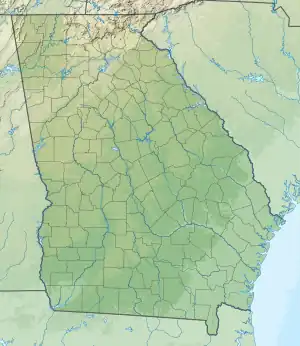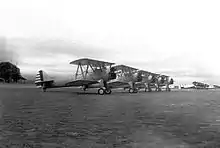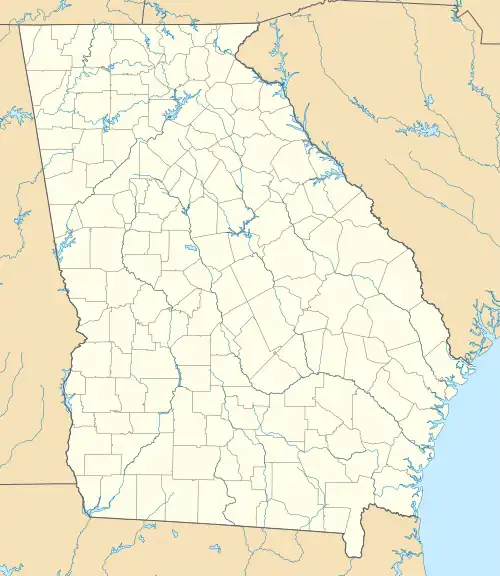Southwest Georgia Regional Airport
Southwest Georgia Regional Airport (IATA: ABY, ICAO: KABY, FAA LID: ABY) is an airport four miles southwest of Albany, in Dougherty County, Georgia, in the United States.[1] The National Plan of Integrated Airport Systems for 2011–2015 categorized it as a primary commercial service airport.[2] Federal Aviation Administration records say the airport had 39,200 passenger boardings (enplanements) in calendar year 2008,[3] 33,044 in 2009 and 35,494 in 2010.[4]
Southwest Georgia Regional Airport (former Albany Army Airfield) | |||||||||||||||
|---|---|---|---|---|---|---|---|---|---|---|---|---|---|---|---|
 USGS 2006 orthophoto | |||||||||||||||
| Summary | |||||||||||||||
| Airport type | Public | ||||||||||||||
| Owner | City of Albany | ||||||||||||||
| Serves | Albany, Georgia | ||||||||||||||
| Elevation AMSL | 196 ft / 60 m | ||||||||||||||
| Coordinates | 31°32′08″N 84°11′40″W | ||||||||||||||
| Map | |||||||||||||||
 ABY  ABY | |||||||||||||||
| Runways | |||||||||||||||
| |||||||||||||||
| Statistics (2022) | |||||||||||||||
| |||||||||||||||
History

Albany Airport opened in 1935, about 4 miles southwest of the city. In October 1938 Eastern Air Lines began mail service to the field. Eastern's Eddie Rickenbacker announced that as soon as the City improved the airport, Eastern would start passenger service. The City was doing just that during 1939 and 1940 in the form of a WPA project to enlarge the landing area and build a passenger terminal.
In 1940 the United States Army Air Corps was establishing civil pilot training schools at airports in the southeast, with its moderate weather. Albany Airport had been rejected as an advanced training base (Turner Army Airfield was built north of Albany instead), but it was approved for a primary contract school in June. The City agreed to provide $500,000 for further improvements to the landing field, the completion of the passenger terminal, the cost of two new hangars and half the cost of a third hangar. An additional investment of over $400,000 was made by Hal S. Darr, owner of the contract flying school for the construction of the cantonment area and one half the cost of one hangar. Ground was broken in July 1940. The Army Air Corps named the school the 52nd Army Air Force Fight Training Detachment. Thus Darr Aero Tech became the first Army Air Corps activity constructed in Georgia during the buildup to World War II. In addition to the main school at Albany, the following auxiliary airfields were used:
- Hayley Auxiliary Field 31°27′30″N 084°11′30″W
- Reynolds Auxiliary Field 31°27′40″N 084°27′38″W
- River Auxiliary Field (location undetermined)
- Turner Auxiliary Field (location undetermined)


On August 15, 1940 the first class of 45 cadets began training. The cadets were initially housed in the Georgia Hotel until the barracks reached completion on 20 August. Flight training commenced with 15 PT-13 Stearmans and 11 flight instructors. Seven classes of American cadets were trained until July 1941. On June 8, 1941, the school received the first British RAF cadets under the Arnold Scheme. For the next 14 months, Darr's classes were exclusively British. A conflict existed between Turner and Darr over airspace. Generally, Turner's airspace was north of Albany and Darr's south of Albany. Where the areas overlapped, Turner's aircraft flew above 5,000 ft. and Darr's below 5,000. Darr's three auxiliary fields were south of Albany.
During the first year of operation Darr Aero Tech graduated 559 American and 86 British cadets. The last British class graduated on October 10, 1942. The seven British cadets killed at Darr and Turner Field, were interred at Albany's Crown Hill Cemetery. A granite monument and flagpole erected by the Albany American Legion Post 30 mark the graves today.
On December 11, 1941, the Defense Plant Corporation bought the school from Mr. Darr for $408,000 and the airfield was called Albany Army Airfield. Anticipating an increase in training, an additional $100,000 was spent on improvements in 1942 that included a dispensary, cold storage building, additional barracks and a Link Trainer building. After the end of 1943 training began to decrease, eventually ending with the closing of the school on December 28, 1944.
In September 1945 control of the airfield was turned over to the City of Albany, and Eastern resumed service in 1945. Southern arrived in 1949; Eastern pulled out in 1971 and the DC-9s of Southern's successor Republic left in 1984.
The airport eventually received paved runways. In 1959 a new terminal building was completed and named in honor of Mayor Bill McAfee, who had recently died. In 2004, the only structures of Darr Aero Tech remaining are the three hangars. No trace of the cantonment area exists.
Albany Army Airfield and Darr Aero Tech is remembered by a display inside the terminal building plus a memorial and flagpole outside. [5][6][7] [8]
Facilities
The airport covers 980 acres (397 ha) at an elevation of 196 feet (60 m). It has two asphalt runways: 5/23 is 6,601 by 148 feet (2,012 x 45 m) and 17/35 is 5,219 by 148 feet (1,591 x 45 m).[1]
In the year ending November 30, 2022 the airport had 18,240 aircraft operations, average 50 per day: 53% general aviation, 21% military, 15% air taxi, and 11% airline. 37 aircraft were then based at the airport: 24 single-engine, 7 multi-engine, 4 jet, and 2 helicopter.[1]
The production facilities for Thrush Aircraft are next to the airport.
Airlines and destinations
Passenger
| Airlines | Destinations |
|---|---|
| Delta Connection | Atlanta |
| Destinations map |
|---|
Destinations from Southwest Georgia Regional Airport |
Cargo
| Airlines | Destinations |
|---|---|
| UPS Airlines | Jacksonville (FL), Louisville, Orlando, Pensacola, Philadelphia, West Palm Beach Seasonal: New Orleans |
Statistics
| Carrier | Passengers (arriving and departing) |
|---|---|
| Endeavor Air | 65,050(100%) |
| Rank | City | Airport | Passengers |
|---|---|---|---|
| 1 | Atlanta, GA | Hartsfield–Jackson International (ATL) | 65,050 |
References
- FAA Airport Form 5010 for ABY PDF. Federal Aviation Administration. Effective July 13, 2023.
- "2011–2015 NPIAS Report, Appendix A" (PDF, 2.03 MB). National Plan of Integrated Airport Systems. Federal Aviation Administration. October 4, 2010.
- "Enplanements for CY 2008" (PDF, 1.0 MB). CY 2008 Passenger Boarding and All-Cargo Data. Federal Aviation Administration. December 18, 2009.
- "Enplanements for CY 2010" (PDF, 189 KB). CY 2010 Passenger Boarding and All-Cargo Data. Federal Aviation Administration. October 4, 2011.
-
 This article incorporates public domain material from the Air Force Historical Research Agency.
This article incorporates public domain material from the Air Force Historical Research Agency. - Manning, Thomas A. (2005), History of Air Education and Training Command, 1942–2002. Office of History and Research, Headquarters, AETC, Randolph AFB, Texas OCLC 71006954, 29991467
- Shaw, Frederick J. (2004), Locating Air Force Base Sites, History’s Legacy, Air Force History and Museums Program, United States Air Force, Washington DC. OCLC 57007862, 1050653629
- Shettle, M. L. (2005), Georgia's Army Airfields of World War II. ISBN 0-9643388-3-1
- "Albany, GA: Southwest Georgia Regional (ABY)". Bureau of Transportation Statistics. April 2013. Retrieved July 27, 2013.
External links
- Southwest Georgia Regional Airport, official site
- Aerial image as of December 1999 from USGS The National Map
- FAA Airport Diagram (PDF), effective October 5, 2023
- FAA Terminal Procedures for ABY, effective October 5, 2023
- Resources for this airport:
- AirNav airport information for KABY
- ASN accident history for ABY
- FlightAware airport information and live flight tracker
- NOAA/NWS weather observations: current, past three days
- SkyVector aeronautical chart for KABY
- FAA current ABY delay information

